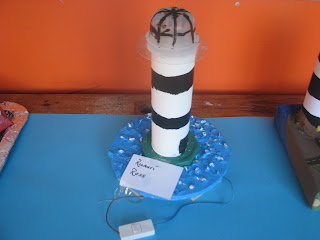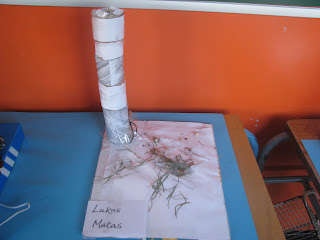We made these cars with recycled materials that are usually thrown out! Cardboard boxes, bbq sticks, old objects, plastic bottles and bottle tops, old toys, wood, butter tubs and lots more recycled materials were used to make these. We had to make the car move using an axel and four wheels. Some people added paint to theirs to finish it off. We had a lot of fun making them. It just goes to show that old rubbish can come in useful!!
Friday, February 18, 2011
Thursday, February 17, 2011
Recylcling to make art
For art we had to make Kilmainham Gaol out of recycled things. For the cells we had to use old shoeboxes. Before we started making them we learned what else was in a cell back then and then used recycled items to make them.
First we got divided into two and then used fist sized sponges to paint the shoe boxes. We mixed black and white paint to make grey and then used the sponges to lightly paint the cells. After the cells were painted and dried, we used items that were brought in from home, such as egg cartons, tin foil, matchboxes, paper, old bits of fabric etc. Back then there wasn't a lot of furniture in the cells. There was only a candle that was supposed to last two weeks, a pine bed, a chair, a bucket and a barred window. Some people used items to make prisoners as well.
While we were doing that two other boys were making stairs for the gaol. They used a cardboard tube and then glued tinfoil to the tube and then stuck matchsticks, the size of a toothpick, for the steps.
Afterwards we got a huge sheet of card and painted it grey and black to make it look dirty. While it was drying we got two big shoeboxes for the top of the gaol and stuck them together and put the stairs in the middle. We did the same to the other cells.
Finally we found a lid, painted it black, put it on top for the roof and then we were finished.
This is how we made our recylcable gaol.
By Liam Turner
Room 17
Ms. A. Hodnett
First we got divided into two and then used fist sized sponges to paint the shoe boxes. We mixed black and white paint to make grey and then used the sponges to lightly paint the cells. After the cells were painted and dried, we used items that were brought in from home, such as egg cartons, tin foil, matchboxes, paper, old bits of fabric etc. Back then there wasn't a lot of furniture in the cells. There was only a candle that was supposed to last two weeks, a pine bed, a chair, a bucket and a barred window. Some people used items to make prisoners as well.
While we were doing that two other boys were making stairs for the gaol. They used a cardboard tube and then glued tinfoil to the tube and then stuck matchsticks, the size of a toothpick, for the steps.
Afterwards we got a huge sheet of card and painted it grey and black to make it look dirty. While it was drying we got two big shoeboxes for the top of the gaol and stuck them together and put the stairs in the middle. We did the same to the other cells.
Finally we found a lid, painted it black, put it on top for the roof and then we were finished.
This is how we made our recylcable gaol.
By Liam Turner
Room 17
Ms. A. Hodnett
Monday, February 14, 2011
The boys in Br. Kinsella's fourth class were asked to use the information they'd learned about batteries and electricity in science to design and construct lighthouses with flashing lights. In line with the school's green school ethos they were asked to use only recycled materials in the construction. As you can see from the pictures they did a great job!
| Classroom survey 21st January, 2011 | ||||
| | No. of pupils | Lunchboxes or re-useable lunch bags in use: | Re-useable drinks containers in use: | Recycling bag in use in the classroom: |
| Room 1 | 30 | 26 | 30 | Yes |
| Room 2 | N/A | N/A | N/A | Yes |
| Room 3 | N/A | N/A | N/A | No |
| Room 4 | N/A | N/A | N/A | No |
| Room 9 | 22 | 13 | 20 | Yes |
| Room 10 | 27 | 20 | 11 | Yes |
| Room 11 | 25 | 20 | 14 | Yes |
| Room 13 | 22 | 18 | 12 | No |
| Room 14 | 22 | 18 | 16 | Yes |
| Room 15 | 32 | 32 | 26 | Yes |
| Room 16 | 20 | 18 | 18 | Yes |
| Room 17 | 20 | 19 | 18 | No |
| Art room | N/A | N/A | N/A | Yes |
| Office | N/A | N/A | N/A | Yes |
| Staff room | 17 staff members | | | Yes |
What should I put in recycling bags?
What should I put into the recycling bags?
· Tetra Pak cartons
· Paper
· Newspapers
· Junk mail
· Magazines
· Light card
· All clean plastics
(Only clean and dry materials should be put into the bags.)
What should I not put in recycling bags?
What should I NOT put into the recycling bag?
· Tin foil and food trays
· Wallpaper
· Glass
· Envelopes with plastic windows
· Construction and demolition waste
· Electrical or IT equipment
· Household hazardous waste
· Garden waste
· Organic waste
· Tissue paper

What should I put in compost bins?
What should I put in compost bins?
Anything organic, i.e. anything that was once living, whether animal or vegetable, can be composted but some materials are more appropriate than others for home composting.
Organic material falls into two categories: Green and BrownGreen or “nitrogen rich” organic material is wet and often green like grass clippings or fruit and vegetables.
Brown or “carbon rich” organic material is dry, woody material that is usually brown, such as fallen leaves and tree-cuttings.
The following list of materials can be composted at home. It has been separated into “Green” and “Brown” for simple identification.
| Green | Brown |
# Activators are the primary food of the organisms and help to establish the bin or speed up the process. |
* Newspapers, cardboard and paper can be added in small crumpled amounts but it is better to recycle them if you can. |
What should I not put in compost bins?
What should I NOT put in compost bins?
Some organic materials are not suitable for home composting. The following is a list of materials that should not be composted at home and the reasons for their exclusions.
| Waste Item | Why should I not put it into a compost bin? |
| Meat and fish scraps | Attract pests |
| Grease and oil | Slow to decompose and attract pests. |
| Cat litter or cat/dog faeces | Temperature of the bin too low to kill pathogens (diseased cells) |
| Glossy papers or magazines | Plastic coating will not compost |
| Barbeque and coal ashes | Coals have been chemically treated and will chemically contaminate the compost |
| Large woody material | Slow to compost |
| Evergreen shrubs | Too acidic |
| Disposable nappies or septic tank sludge. | Temperature of the bin too low to kill pathogens (diseased cells) |
Friday, February 11, 2011
Mats using old newspapers
This week in room 16 we made mats from recycled newspaper without using any glue or sellotape.We wove strips of newspaper to make them.They are very comfortable to sit on in class.













